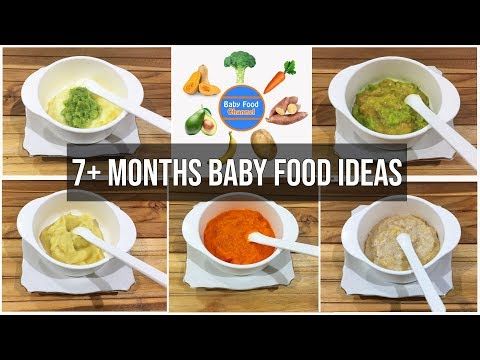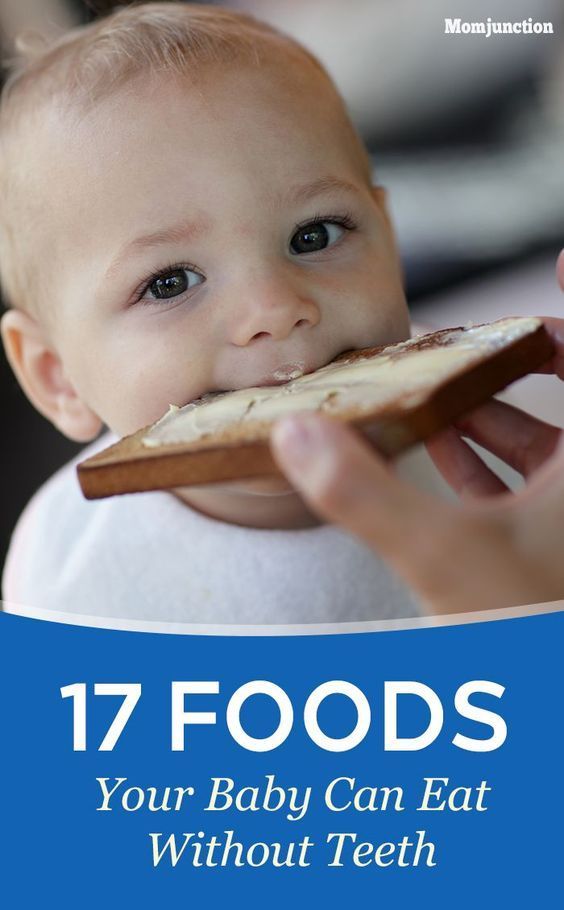Seven month baby food
What To Feed Your Baby | 7 to 9 mths | Weaning
Baby's age
- Around 6 months
- 7 - 9 months
- 10 - 12 months
- 12 months+
7 - 9 months
By now, your baby will have had some good practice learning how to eat! Eat together as much as possible – they learn a lot from watching you.
Your baby will gradually move towards eating 3 meals a day (breakfast, lunch and tea). Offering a wide variety of different foods is important to ensure they get enough energy and nutrients (such as iron). Babies don't need salt or sugar added to their food (or cooking water) – salty food isn't good for their kidneys and sugar can cause tooth decay.
Remember, it may take 10 tries or even more for your baby to get used to new foods, flavours and textures. There'll be days when they eat more, some when they eat less, and then days when they reject everything! Don't worry – this is perfectly normal. Just be patient, keep offering a variety of foods, even the ones they don't seem to like, and let them get used to it in their own time.
Babies under 12 months don't need snacks, if you think your baby is hungry in between meals, offer extra milk feeds instead.
Smooth or lumpy?
Hopefully your baby will now be more confident exploring new textures. Offer more mashed, lumpier foods as well as a variety of finger foods. Giving your baby finger foods helps them learn to feed themselves, develop hand-eye co-ordination and learn to bite off, chew and swallow small pieces of soft food.
Babies take different amounts of time to get used to lumps, but it's an important skill they need to learn. Just keep offering them lumpy textures and finger foods and stay with them so you can be sure they are swallowing it safely.
What is baby-led weaning?
Baby-led weaning means offering your baby only finger foods and letting them feed themselves from the start (rather than spoon feeding them puréed or mashed food). You can offer a range of small, finger-sized, pieces of food.
You can offer a range of small, finger-sized, pieces of food.
Some parents prefer baby-led weaning to spoon feeding, while others combine a bit of both. There's no right or wrong way – the most important thing is that your baby eats well and gets all the nutrients they need.
Should I still give my baby breast milk or first infant formula?
Yes. Breast milk or first infant formula is still important for energy and nutrients during the first year, and should be their main drink until 12 months. You can continue breastfeeding for as long as you both want. As time goes on and your baby eats more solids, they may naturally want less breast milk or first infant formula.
If you're breastfeeding, your baby will adapt their feeds according to how much food they're having. Formula-fed babies may need around 600ml of milk a day, but just use this as a guide. Remember your baby's tummy is tiny and fills up quickly, so offer milk feeds after solids and don't force them to finish the bottle.
Drinks?
Solids, Food Chart And Recipes
This food chart will help ensure that your baby’s solid food diet meets their needs.
Research-backed
MomJunction believes in providing reliable, research-backed information to you. As per our strong editorial policy requirements, we base our health articles on references (citations) taken from authority sites, international journals, and research studies. However, if you find any incongruencies, feel free to write to us.
Image: Shutterstock
If your baby has been transitioning from breastmilk to solid foods, a 7-month-baby food chart can be a helpful guide. During the first six months of life, babies drink breast milk or formula milk to get their complete nutrition. However, after six months, their needs can increase, and it is time to introduce solid foods.
Keeping the transformation slow and introducing foods one by one is essential. Try offering easily digestible, cooked, and mashed food first, then move toward blends. Keep the quantity small and be cautious about choking hazards.
Keep the quantity small and be cautious about choking hazards.
This post provides detailed information on what to feed your 7-month baby and what quantities. It also provides a food chart with some interesting recipes.
How Much Food Should A 7-Month-Baby Eat?
AAP recommends mothers to continue breastfeeding their baby for at least up to 12 months. At seven months, continue to breastfeed your baby while giving them some solid foods. Blanca Garcia, RDN, nutrition specialist at MIDSS, says, “At seven months, an infant’s diet should be mostly breastmilk or formula. If solid foods have already started, they should be complementary to the milk. Only a few small spoons thrice a day are fine, but not whole meals that replace the milk altogether.” According to the US Department of Agriculture (USDA), following portions of food from different food groups may be included in your seven months old baby’s diet (1) (2).
| Food group | Portion size (per day) |
|---|---|
| Breast milk or formula milk | 24 to 32 ounces (oz) |
| Grain products | 1 to 2oz |
| Fruits | 2 to 4oz; cooked, plain/strained/pureed/mashed |
| Vegetables | 2 to 4oz; cooked, plain/strained/pureed/mashed |
| Meat and protein-rich foods | 1 to 2oz; Cooked, plain/strained/pureed/mashed |
Food Options For Your Seven Months Old Baby
Traditionally, parents start with single-grain cereals (3) or single vegetable and fruit (blended, mashed or soft cooked). When your baby is around seven to nine months old, you may include a variety of foods from different groups (2) (4).
When your baby is around seven to nine months old, you may include a variety of foods from different groups (2) (4).
Garcia recommends, “Give foods that a seven-month-old can easily chew, such as pieces of banana (mostly mashed), mashed beans and strawberries, age-appropriate cookies, whole-grain pasta, whole-wheat bread, and steamed veggies, such as green beans and peas.”
| Food group | Food items |
|---|---|
| Vegetables | Broccoli, cauliflower, peas, spinach, asparagus, parsnips, peppers, carrots, cabbage, avocado, green beans, kale, and pumpkin |
| Fruits | Banana, apple, mango, blueberries, kiwi, pears, strawberries, papaya, melon, peach, plums, and oranges. |
| Starch-rich foods | Potato, sweet potato, rice, porridge, oatmeal, oats, maize, millet, quinoa, cornmeal, and bread |
| Protein-rich foods | Meat (chicken, lamb, fish without bones), eggs, pulses, lentils, beans, and tofu |
| Dairy | Pasteurized full-fat yogurt without honey, sugar, and artificial sweeteners) Do not serve milk |
Boil and mash hard fruits like apples before serving it to the baby.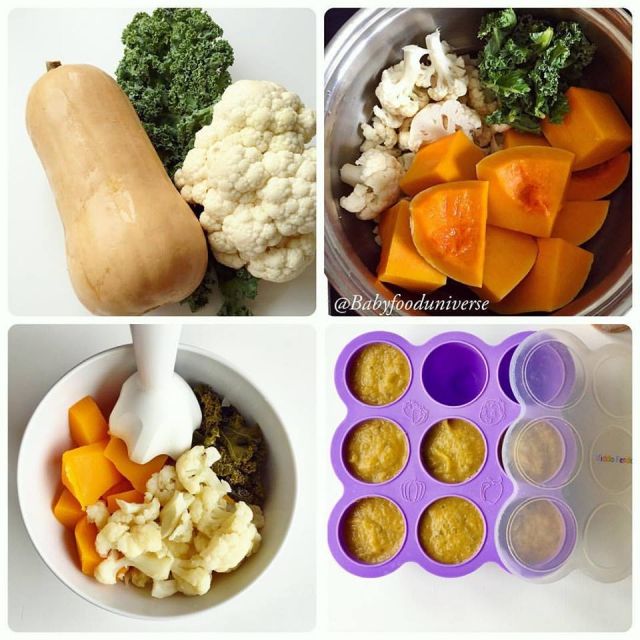 You may blend fruits and vegetable purees with formula or breast milk. When choosing meat, you can also consider serving meat broth.
You may blend fruits and vegetable purees with formula or breast milk. When choosing meat, you can also consider serving meat broth.
Related: How Is Breast Milk Made During Pregnancy & Interesting Facts
All foods should be soft to prevent the risk of choking. Make sure the baby eats slowly and in small portions.
Quick tip
Feeding the baby upright or placing them in a high chair during mealtime can help prevent choking (13).
Click here to view an enlarged version of this infographic.
10 Homemade Baby Food Recipes For Your Seven Months Old
You can try these simple nutrient-rich homemade recipes to introduce your child to different flavors and textures of food (5).
1. Steamed apple and pear puree
Image: Shutterstock
You will need:
- ½ apple, peeled and de-seeded
- ½ pear, peeled
How to:
- Cut the apple and pear into wedges or chunks.
 Put these pieces in a saucepan with water.
Put these pieces in a saucepan with water. - Bring the water to boil and let it simmer for about 7-8 minutes. Allow it cool.
- You can make a puree and also use them as finger food (if your baby is ready to eat finger food). You can use yogurt as a dressing!
Related: Apple Puree For Baby: Benefits, Recipes And Precautions
2. Eggy omelet fingers
Image: Shutterstock
You will need:
- 1 small onion, peeled and chopped
- 1 egg
- ½ teaspoon oil
How to:
- Beat the egg. Cut the onion into small pieces and add it to the egg. Whip them together.
- Put oil in a frying pan. Once the pan is hot, add the mixture and let it cook.
- Let the omelet cool. Cut it into thin slices, and serve it to the baby.
3. Hot lentil soup
Image: Shutterstock
You will need:
- Handful of butternut squash peeled
- ¼ onion peeled and chopped
- 30 g red lentils
- ½ tsp oil
- Water
How to:
- De-seed and cut butternut squash into pieces.
 Finely chop the onions.
Finely chop the onions. - Heat oil in a frying pan. Add all diced vegetables and let them soften.
- Then add water and washed/cleaned lentils to the pan. Bring the water to boil and let it simmer for about 20-25 minutes.
- Check if vegetables and lentils have cooked. Once cooked, let the mixture cool down and blend it before serving.
Related: 27 Healthy Soup Recipes For Babies (6-12 Months)
4. Berry porridge
Image: Shutterstock
You will need:
- 2 tablespoon porridge oats
- ¼ banana
- Frozen blueberries (you can use fresh blueberries too)
- 1 tablespoon yogurt
- Water
How to:
- Add oats and water in a saucepan. Let it cook till the mixture thickens and softens.
- Add small pieces or mashed bananas and blueberries as a topping before serving.
5. Tangy chicken fingers
Image: Shutterstock
You will need:
- Skinless chicken breast
- ½ lemon juice
How to:
- Take skinless chicken breast and slice it into thin medium-sized pieces.

- Preheat your oven to 200°C (about 400°F).
- Place the chicken slices in a tray and squeeze a few drops of lemon juice on them.
- Bake the chicken for 25 minutes. Once baked, you can mince it or give it as finger food.
6. Veggie hotpot
Image: Shutterstock
You will need:
- ½ leek
- ½ carrot, peeled and cut
- 1 potato, peeled and cut
- 1 tablespoon beans, chopped
- 1 small broccoli
- 1 teaspoon oil
- Water
How to:
- Peel and cut carrots and potatoes into small pieces. Cut beans and leeks.
- Take a saucepan with water and add leeks, potato, beans, and carrot. Bring it to boil and let it simmer for 15 to 20 minutes till all vegetables are cooked.
- Once cooked and cooled, blend these vegetables into a puree with pasteurized cream cheese.
- In another pan, cook pieces of broccoli in water for 3-4 minutes. Add these as finger food on top of the puree.

7. Pumpkin and thyme puree
Image: Shutterstock
You will need:
- ½ pumpkin peeled and cut
- Thyme leaves
How to:
- Peel, de-seed, and chop pumpkin into small pieces. Place the pieces on a baking tray.
- Preheat oven to 175°C (about 350°F).
- Place the pumpkin and bake for 30 minutes. Once cooled, add thyme and blend it in a mixer.
8. Broccoli and spinach puree
Image: Shutterstock
You will need:
- 1 medium-sized broccoli, chopped
- 5-6 spinach leaves chopped
- Water
How to:
- Bring water to boil in a pan. Add spinach leaves and broccoli florets. Let it simmer for about 10-15 minutes.
- Once cooled, mash it with a fork or blend it before serving to the baby.
Related: Spinach For Babies: Right Age, Benefits And Recipes To Try
9. Avocado and banana mash
Image: Shutterstock
You will need:
- ½ avocado
- 1 banana, peeled
How to:
- Scoop out avocado and keep it in a pan.
 Add banana to it and mash.
Add banana to it and mash. - You can also add formula or breast milk to the mash and blend it before serving.
10. Root vegetables puree
Image: Shutterstock
You will need:
- 1 carrot, peeled and chopped
- 1 sweet potato, peeled and chopped
How to:
- Place the sweet potato and carrot pieces into a saucepan with water. Bring it to boil and let it simmer for around 10-15 minutes or till the vegetables are soft.
- Let the veggies cool down and mash it with a fork or blend before serving.
Seven Months Old Baby Food Chart
You may use this sample food chart for your seven months old baby as a reference (6) (7) (8).
| Meal name | Sample meal |
|---|---|
| Breakfast (morning) | Solid food: ● Iron-fortified infant cereal Liquid: ● Breast milk or formula milk |
| Snack (late morning) | Solid food: ● Pureed or mashed fruits such as banana, kiwi, strawberries, cooked apple, cooked pear with full-fat plain yogurt (unsweetened). Liquid: · Breast milk or formula milk |
| Lunch | Solid food: ● Cooked and finely chopped chicken, ● Cooked and mashed vegetables such as pumpkin, sweet potato, spinach, squash, etc. with cooked and mashed rice. Liquid: ● Breast milk or formula milk |
| Snack (evening) | Solid food: ● Cooked and mashed pear ● Cooked and finely chopped carrots or mashed chickpeas. ● Plain yogurt ● Whole-grain cracker Liquid: ● Breast milk or formula milk |
| Dinner | Solid food: ● Cooked and finely chopped green beans or other cooked vegetables. Liquid: ● Breast milk or formula milk |
Start with one or two tablespoons of food and see if your baby shows signs of being hungry or full. Remember, their bellies are small! You can alternate between solid food and liquids, depending on your baby’s hunger cues.
Try including a variety of colorful foods and textures in the baby’s diet.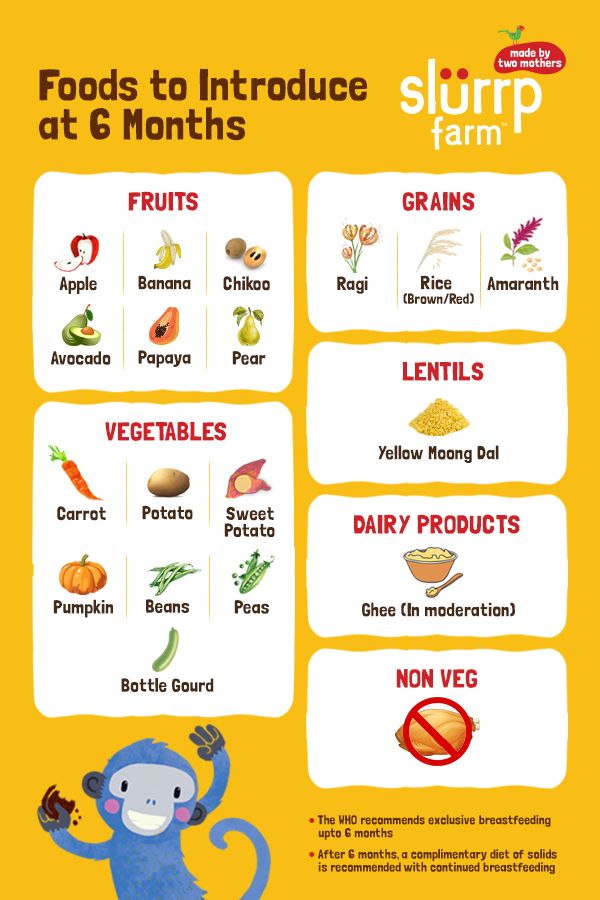 You can also slowly start introducing finger foods by the end of seven months to develop a habit of self-feeding (6).
You can also slowly start introducing finger foods by the end of seven months to develop a habit of self-feeding (6).
Quick tip
Refrain from feeding cereal in the bottle as it may lead to choking. However, the doctor may advise it for babies with reflux (3).
Seven Months Old Baby Food Schedule
According to World Health Organization (WHO), complementary foods (food items apart from breast milk) can be given to babies (six to eight months old) up to two to three times per day (9). In addition, the Centres for Disease Control and Prevention (CDC) recommends that you should give your baby something to drink or eat every two to three hours, that is, about five to six times a day (10).
Tips and Precautions For Feeding A Seven Months Old Baby
These are a few points you should consider when feeding your little one (1) (11).
- Introduce one single ingredient at a time. Give the food item for three to five days, during which you do not give any other new food.
 Observe the baby for any sign of an allergy.
Observe the baby for any sign of an allergy.
- Gradually increase the variety and quantity of food ingredients; start with a teaspoon and then move to a tablespoon.
- You can also try to give finger foods if your baby seems ready. Your baby may start to grasp items with fingers when they are ready for finger foods. Make sure you are present when your baby is eating, to avoid any choking hazards.
Related: 21 Healthy Finger Foods For Toddlers
- Wash, peel, and remove seeds and pits before giving fruits and vegetables to your baby.
- Use a spoon to feed your baby. Make sure your baby sits in a high chair with a table when feeding.
- Observe and respond to your baby’s hunger cues. Try to develop a predictable routine of all meals and snacks for your baby and limit the time of each meal from 15 to 20 minutes.
- Avoid added salt, sugar, and butter when making baby food at home. In addition, avoid cow’s milk and honey until your baby is at least 12 months old.

Jennifer House, MSc, a registered dietitian, author, and owner of First Step Nutrition in Calgary, Alberta, says, “Milk choices for a seven-month old include breastmilk or formula only. They can have cow’s milk in foods such as a smoothie or cereal, but not as their main milk source, as it doesn’t contain enough fat and calories.”
How to Know When a Baby Is Ready for Solid Food?
According to the American Academy of Pediatrics (AAP), the following points could indicate that the baby is ready for solid food (3).
- Has good head control.
- Can sit upright in a high chair or a feeding seat (with no or little support).
- Tries to reach out (leans forward) for solid food.
- Opens mouth and seems eager to eat solid food when offered.
- Their fingers are able to grasp items, this is a sign that they are ready for solid/ finger foods.
Did you know?
The baby may take ten or even more tries to get used to new textures, flavors, tastes, and foods (4).
1. What are some common food allergies that a 7-month-old baby may have?
The common food allergens for babies include eggs, wheat, soy, tree nuts, fish, and shellfish (14).
2. How much water should a 7-month-old baby be drinking each day?
A 7-month-old can get enough water from solid foods and breast milk. However, they can have four ounces or 120 ml of extra water on regular days and up to eight ounces or 240 ml of extra water in hot summers (15).
According to UNICEF, delaying the introduction of solid foods may affect a baby’s healthy weight gain (12). So, encourage your baby to eat solids as soon as they show signs of readiness. A 7-month-old baby’s food chart can include various healthy foods, such as grains, pulses, meat, fish, poultry, fruits, and vegetables. With continued breastfeeding or formula feeding, babies can consume these foods in well-cooked puree or mash form.
They can also consume age-appropriate finger foods if they show signs of readiness. Feed them nutritious foods and drinks every two to three hours to support their proper growth and development. If the baby eats lesser than usual on some days, refrain from force-feeding. Remember, the main source of nourishment even for a seven-month-old is breast milk or formula. They can have solids but in small quantities, as they need time to adjust to weaning food’s taste, texture, and digestibility.
Feed them nutritious foods and drinks every two to three hours to support their proper growth and development. If the baby eats lesser than usual on some days, refrain from force-feeding. Remember, the main source of nourishment even for a seven-month-old is breast milk or formula. They can have solids but in small quantities, as they need time to adjust to weaning food’s taste, texture, and digestibility.
Key Pointers
- 7-month-olds should primarily consume breast milk or formula, with solid foods being complementary to their diet.
- Introduce solid foods gradually, starting with easily digestible, cooked, and mashed options.
- Begin with single-grain cereals, single fruits, and vegetables, then gradually introduce more variety.
- Offer soft, easily chewed foods like bananas, green beans, and whole-grain pasta.
- Foods suitable for 7-month-olds include broccoli, banana, sweet potato, chicken, yogurt, and more.
- All solid foods should be soft to prevent choking.

- Feed the baby upright and in small portions.
References:
MomJunction's articles are written after analyzing the research works of expert authors and institutions. Our references consist of resources established by authorities in their respective fields. You can learn more about the authenticity of the information we present in our editorial policy.
1. Guidelines for feeding healthy infants; The United States Department Of Agriculture. (2017)
2. Healthy Eating for 6 to 24 month old children (1) Getting Started; Family Health Service, The Government of the Hong Kong Special Administrative Region. (2019)
3. Starting Solid Foods; American Academy of Pediatrics. (2018)
4. What to feed your baby; National Health Service, UK
5. Recipes and meal ideas; National Health Service, UK
6. Menu planning for babies in childcare; Health Eating and Advisory Service
7. Feeding Your Baby: Sample Meals for Babies 6- 12 Months Old; HealthLinkBC. (2014)
Feeding Your Baby: Sample Meals for Babies 6- 12 Months Old; HealthLinkBC. (2014)
8. Sample Meal Plans for Feeding Your Baby; UnlockFood.Ca. Dietitians of Canada. (2019)
9. What is the recommended food for children in their very early years?; World Health Organization (2011)
10. How much and how often to feed; Centers for Disease Control and Prevention (2018)
11. Feeding Guide for the First Year; Stanford Children’s Health
12. Feeding your baby: When to start with solid foods; UNICEF Parenting
13. Preventing Choking in Babies; Children’s hospital Colorado
14. Food Allergies in Children; University of Rochester Medical Center
15. Bottle-Feeding (Formula) Questions; Seattle Children’s Hospital
The following two tabs change content below.
- Reviewer
- Author
- Expert
Diet for a child aged 7 months
When compiling a diet for a seven-month-old baby, distribute the products so that you get a certain prototype of the menu of an already grown-up child with breakfast and lunch.
At this age, the yolk of a boiled chicken egg, a valuable source of fat, vitamin B12, A, phosphorus and selenium, is introduced into the child's diet. Chopped yolk can be added to porridge or vegetable puree.
At the age of 7 months, you can already give your baby a cracker (in the form of dried bread) and baby biscuits.
The volume of fruit puree and juice is increased to 70 g.
It is still better to give preference to commercially produced complementary foods, given their high degree of safety and variety. If the baby does not perceive a new product the first time, it can be mixed with an already familiar product.
Approximate diet for a child aged 7 months.
| I feeding 6 hours | Breast milk or VHI* | 200 ml |
| II feeding 10 hours | Dairy-free or milk porridge ** Butter Boiled egg yolk Supplementation with breast milk or VHI | 150 g |
| III feeding 14 hours | Vegetable puree Vegetable oil Meat puree Fruit juice | 170 g approx. 1 tsp. 30 g 70 ml |
| IV feeding 18 hours | Fruit puree Baby biscuits Breast milk supplement or VHI | 70 g |
| V feeding 22 hours | Breast milk or VHI | 200 ml |
* - infant formula
** - dairy-free porridge should be diluted with breast milk or infant formula that the child receives. Milk porridge is diluted with water.
Approximate diet of a 7-month-old child with cow's milk protein allergy:
| I feeding 6 hours | Breast milk or formula for infants with intolerance to cow's milk proteins | 200 ml |
| II feeding 10 hours | Dairy-free porridge* Vegetable oil Fruit puree (apple, pear) | 130 g approx. 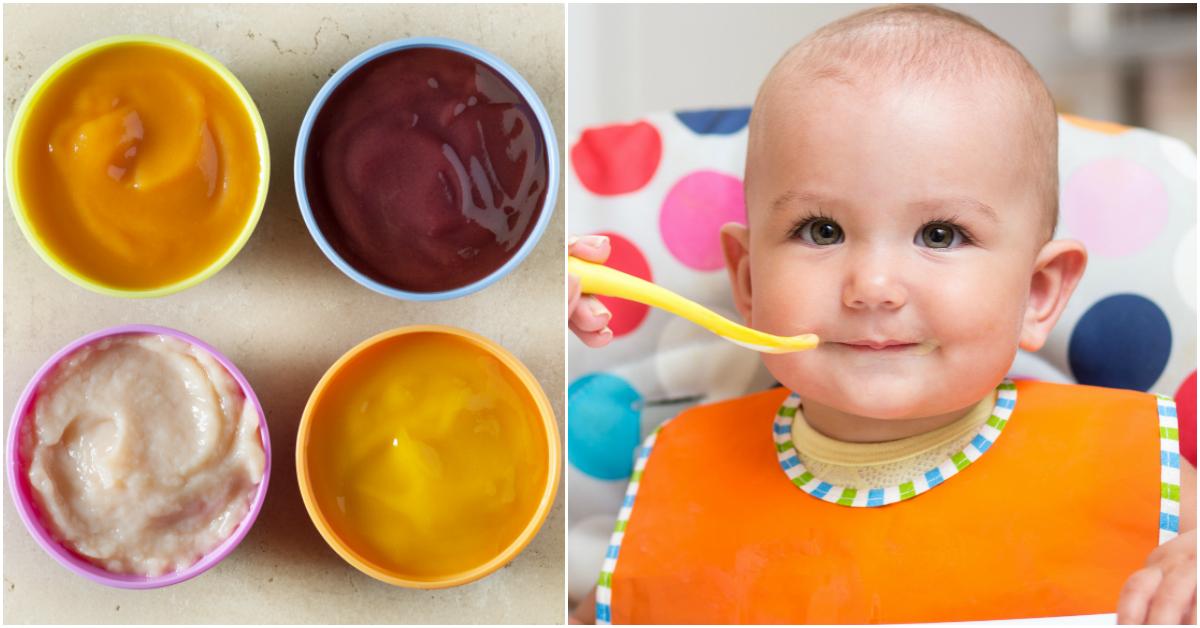 1 tsp. 1 tsp. 70 g |
| III feeding 14 hours | Vegetable puree Vegetable oil Meat puree (rabbit, turkey) | 170 g approx. 1 tsp. 30 g |
| IV feeding 18 hours | Vegetables or dairy-free porridge** Vegetable oil Meat puree | 180 g approx. 1 tsp. 20 g |
| V feeding 22 hours | Breast milk or medicated formula for infants with cow's milk protein intolerance | 200 ml |
* - dairy-free porridge should be diluted with breast milk or formula for children with intolerance to cow's milk proteins.
** - you can either alternate porridge or vegetables, or offer a mixed dish - porridge with vegetables.
Baby menu at 7 months: what is possible and what is not yet
- Anastasia Ivanovna, what are the nutritional features of children at 7 months?
- The menu for a baby at seven months is different from the menu for a newborn and a baby at one year old.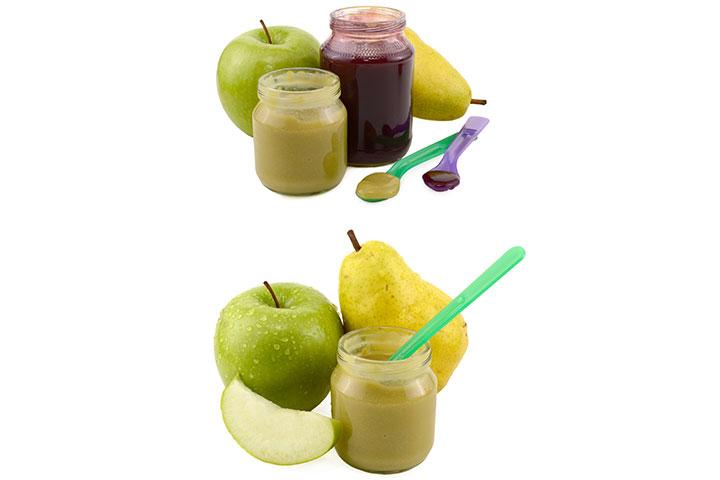 This difference exists due to the fact that a number of body systems, including the gastrointestinal tract and oral cavity, have not yet been formed in a newborn, he is only learning to suck. From four to six months, the diet begins to include complementary foods - food that is different from breast milk or infant formula. In the year of the child, in ideal conditions, they are transferred to a common table.
This difference exists due to the fact that a number of body systems, including the gastrointestinal tract and oral cavity, have not yet been formed in a newborn, he is only learning to suck. From four to six months, the diet begins to include complementary foods - food that is different from breast milk or infant formula. In the year of the child, in ideal conditions, they are transferred to a common table.
Some pediatricians recommend introducing complementary foods from five to six months, sometimes even from four. But the enzymatic system of the baby's body has not yet been formed, so pedagogical complementary foods are possible at four or five months, and pediatric complementary foods by six months.
— How to combine breastfeeding or bottle feeding with complementary foods?
— Pediatricians and nutritionists recommend separating these meals and giving the main dairy food and complementary foods in separate meals so that the child understands what he is eating.
If complementary foods started at 4-5 months
— What rules of baby food should parents know?
— The functions of the gastrointestinal tract are formed in such a way that the body needs to adapt to the incoming products. With proper complementary foods, it is important to monitor the child's condition in the food diary and, if necessary, consult a doctor.
Basic feeding recommendations for seven-month-old babies
- One new product is given in small doses at the beginning of the day every four days to monitor for allergies, constipation, peeling and other reactions.
- One new food can be given per feeding.
- Water is best offered between feedings and not given with complementary foods.
- Do not force-feed: if the child refuses a certain dish, it can be offered at another time and in a different form.
- The child is not given unfamiliar food when he is not in a very good mood, teething, or has just been vaccinated.
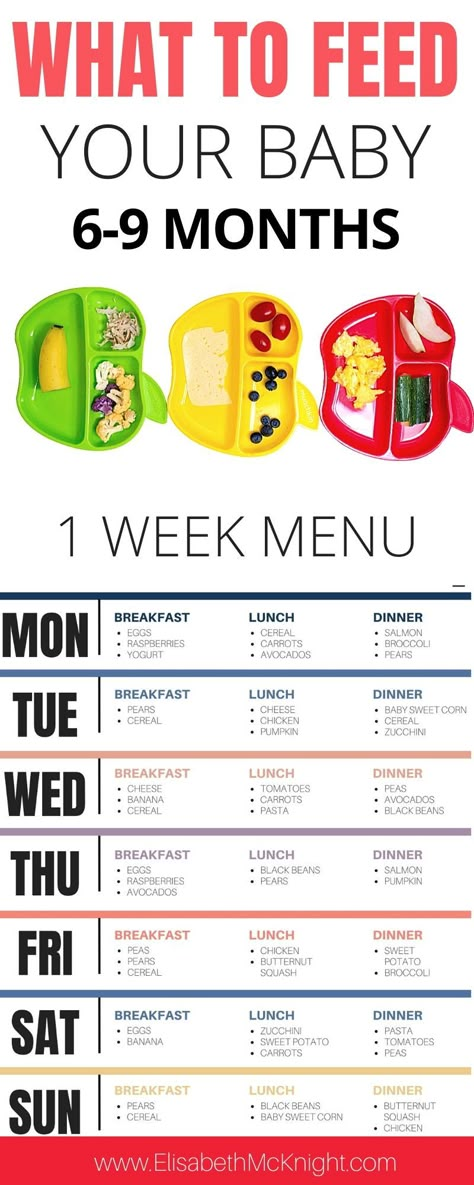
- How to identify food allergies and find the allergen?
- Observant mothers will see or hear the problem. The baby will have something on the body, constipation or indigestion will begin. A restless child will cry. To track the allergen, it is advisable to keep a food diary and keep your finger on the pulse. If there is a connection with the pediatrician, ask questions and, taking into account the vaccination calendar, the physiology of the development of your child, offer him certain products so as not to once again provoke an immune response.
What foods can be given at 7 months
Read also
- Why it is necessary to introduce meat complementary foods into the baby's diet and with what products it can be combined.
- What purees and cereals can be given at 7 months?
- If this is the first complementary food for a baby, then monocomponent purees, dairy-free and milk porridges with one cereal in the composition are good: they are easier to digest and it is easier to track the reaction of the body using them.
— In what order can complementary foods be given?
— If your baby is overweight by the age of seven months, it is better to feed him vegetable puree. If everything is in order with weight, then preference can be given to cereals. All new products are introduced gradually: they begin to feed in the amount of 5-10 g, gradually increasing the volume to 50 g. By seven months, a portion of porridge at one time can reach up to 200 g. The third option for complementary foods, if parents want, can be fruit. It is in this sequence, because fruits are sweet, and the child does not always eat unleavened vegetables or cereals after them.
Each product will also have its own processing specifics:
- vegetables and fruits are given in the form of puree;
- purchased cereals are prepared according to the instructions;
- homemade porridges are boiled in water, then milk or mixture is added if desired;
- cottage cheese is properly stored in the refrigerator, tracking the expiration date;
- dairy, vegetable broths are brought to a single consistency (puree) so that the child develops the correct perception of the product.
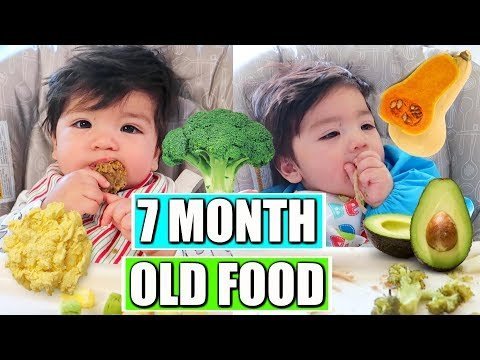
— How many times to feed a baby at 7 months and how much food to give?
- You need to focus on five feedings per day. If your baby cannot tolerate the interval between meals, it is worth supplementing with breast or formula after the introduction of complementary foods.
How to calculate complementary foods
A baby at seven months should weigh about eight kilograms. 1/8 of the child's weight is the daily amount of food, that is, approximately a kilogram of food, taking into account all feedings, or 200 grams per meal.
Sample menu for a 7-month-old baby (Russian Federation)
— At what age can semi-solid and solid foods be introduced into a child's diet?
- By 6 months, most babies are ready for a new food: the baby realizes that something is hard in his mouth. By the age of seven months, the skill of palmar grip is formed: the child is able to hold solid food in his hand, and he can be given biscuits and crackers to grind. Allergists and pediatricians consider 6-10 months as the optimal period to begin the introduction of semi-solid and solid foods. But if the swallowing apparatus is not formed, there may be problems with chewing and swallowing disorders up to the gag reflex.
By the age of seven months, the skill of palmar grip is formed: the child is able to hold solid food in his hand, and he can be given biscuits and crackers to grind. Allergists and pediatricians consider 6-10 months as the optimal period to begin the introduction of semi-solid and solid foods. But if the swallowing apparatus is not formed, there may be problems with chewing and swallowing disorders up to the gag reflex.
— What should parents do if their child refuses to eat? How to create food interest?
— It is necessary to understand the reasons for the baby's refusal to eat, among which may be: The pediatrician will track changes in health by analysis and, if necessary, adjust the diet.
At seven months, significant changes occur in the work of the gastrointestinal tract, the child actively shows interest in "adult" products, in new tastes. It will be easier for the baby to readjust if you choose products that will match his physiology and fully cover his needs for growth and communication.